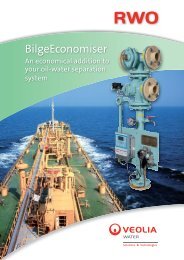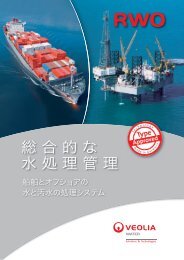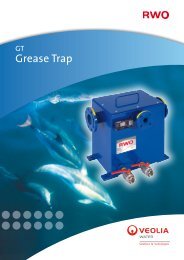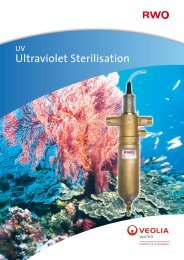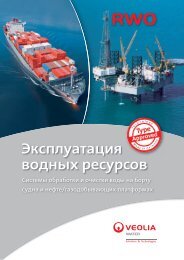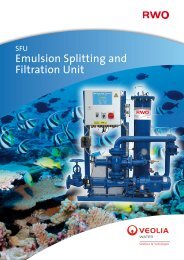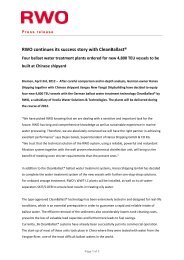the IHS Ballast Water Guide - RWO Marine Water Technology
the IHS Ballast Water Guide - RWO Marine Water Technology
the IHS Ballast Water Guide - RWO Marine Water Technology
Create successful ePaper yourself
Turn your PDF publications into a flip-book with our unique Google optimized e-Paper software.
<strong>IHS</strong> Fairplay Solutions <strong>Guide</strong> to <strong>Ballast</strong> <strong>Water</strong> Treatment Systems Sponsored by<br />
Implementing a system<br />
Twenty-three suppliers have gained<br />
type approval for <strong>the</strong>ir systems so far,<br />
which <strong>the</strong>refore can be sold commercially.<br />
The systems include Alfa Laval with its<br />
Pure<strong>Ballast</strong>, Hamman with SEDNA (but<br />
with production currently suspended),<br />
Hitachi with Clear<strong>Ballast</strong>, Hyde <strong>Marine</strong>’s<br />
Guardian, NEI Treatment Systems with<br />
VOS, Nutech 03 with Blue<strong>Ballast</strong>,<br />
OceanSaver (Mark I version) with its<br />
namesake system, OptiMarin with OBS,<br />
<strong>RWO</strong> with its Clean<strong>Ballast</strong> system,<br />
Techcross with Electro-Cleen, Panasia<br />
with GloEn-Patrol, and Wilhelmsen with<br />
Unitor (at present this has been withdrawn<br />
from <strong>the</strong> market).<br />
Last year Balclor’s BWTS, COSCO with Blue<br />
Ocean Shield, JFE with <strong>Ballast</strong>Ace, Mahle with<br />
its Ocean Protection System, 21st Century<br />
with ARA <strong>Ballast</strong> and Wuxi Brightsky with<br />
its BSKY system were also type approved.<br />
Hyundai HI with Hi<strong>Ballast</strong>, Samsung HI with<br />
its Purimar system and Severn Trent de Nora<br />
with Balpure were approved in July 2011.<br />
The Ecochlor system received type approval<br />
at Europort in November last year from <strong>the</strong><br />
German national authority, Federal Maritime<br />
and Hydrographic Agency (BSH).<br />
Oceansaver’s Mark II system was approved<br />
in January 2012. More than 45 systems<br />
are in development, and <strong>the</strong>re is no lack of<br />
newcomers ready to join <strong>the</strong> movement.<br />
When implementing a ballast water<br />
treatment system a great deal of planning is<br />
essential and searching questions should be<br />
asked before choosing a system for a particular<br />
vessel or fl eet. These considerations are<br />
intended to streamline <strong>the</strong> compliance process<br />
and cut down on costs.<br />
In a newbuilding, <strong>the</strong> shipowner has <strong>the</strong><br />
opportunity to choose <strong>the</strong> treatment system<br />
best suited to <strong>the</strong> vessel type and size, to its<br />
service or trade route, and to <strong>the</strong> owner’s<br />
operational preferences. The system can<br />
be designed in from <strong>the</strong> start, whereas in a<br />
retrofi t choices may be constrained by existing<br />
onboard systems and <strong>the</strong> space available.<br />
Owners, particularly those with multiple<br />
vessel types in <strong>the</strong>ir fl eet, would be well<br />
advised to consider <strong>the</strong>ir options sooner<br />
ra<strong>the</strong>r than later and investigate costs,<br />
including bulk purchases. The o<strong>the</strong>r aspect<br />
of being well prepared is planning for<br />
installation during a scheduled drydocking<br />
when trained technicians will be available.<br />
Compliance with <strong>the</strong> BWM<br />
Convention and regulations<br />
All ships must nominate an offi cer<br />
responsible for ballast water management<br />
and because every voyage is diff erent, a<br />
vessel must have a ballast water management<br />
plan (in English, French or Spanish) that<br />
enables a unique procedure to be specifi ed<br />
for each voyage, based on <strong>the</strong> weight and<br />
volume of cargo and fuel.<br />
The BWM plan provides requisite<br />
information to port state control as <strong>the</strong> ship<br />
approaches its territorial waters, in accordance<br />
with IMO regulation B1. It should be agreed<br />
between <strong>the</strong> master and <strong>the</strong> company’s head<br />
offi ce, and contain ship’s particulars, drawings<br />
of <strong>the</strong> vessel’s ballast system, diagrams of<br />
ballast water sampling points, operations<br />
of <strong>the</strong> onboard BWMS, and procedures for<br />
sediment control and disposal. The plan<br />
defi nes reporting procedures and operational<br />
and safety procedures, and it also contains<br />
details of <strong>the</strong> required training for <strong>the</strong> crew.<br />
All ballast water-related activities are<br />
38 © <strong>IHS</strong> Global Limited 2012<br />
038_039_BW1204.indd 38 21/03/2012 18:45:24



